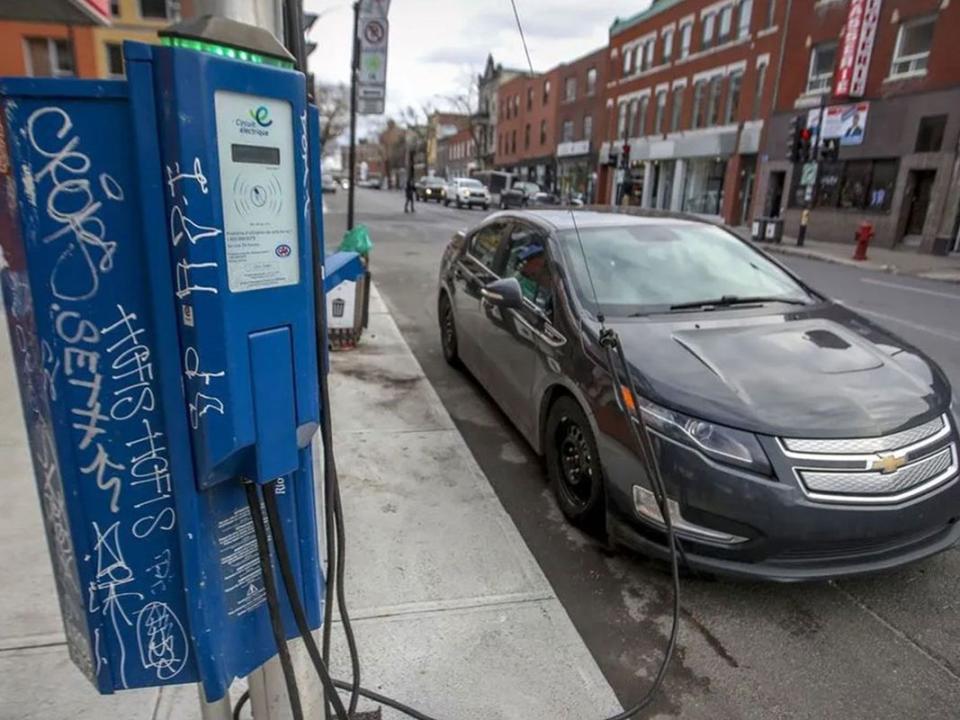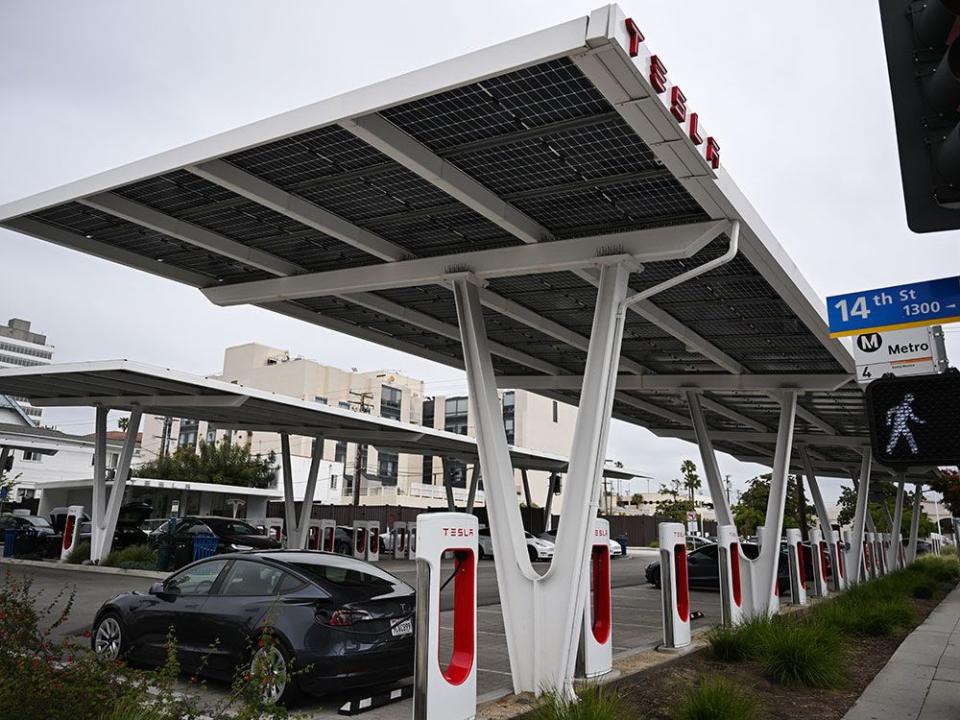EV sales are overtaking charging stations in Canada — and that's a problem

Electric-vehicle charging infrastructure is having a hard time keeping up with EV sales.
Last year, at least 180,000 new EVs hit the road in Canada, a 49 per cent jump from a year earlier, according to BMI, a Fitch Solutions Inc. market research company.
Transport Canada lists 28,188 charging points in total in Canada today, and while estimates of exactly how many chargers were added in 2023 vary, most place the figure around 6,000 — meaning a roughly 33 per cent year-over-year increase.
Charging infrastructure is key to EV adoption. Among consumers who said they would not consider purchasing an EV for their next vehicle, 72 per cent cited a lack of charging station availability as a top concern, according to an Autotrader Canada survey conducted in March.
But there are many challenges to installing EV charging infrastructure in Canada. Here are five of them.
A rapid rollout
New chargers need to be installed at a pace to match EV sales, but some data suggests that isn’t happening yet.
In Canada, the ratio of EVs to public charging stations is around 20, which is double the global average of 10, according to a January 2024 report by consulting firm Mobility Futures Lab and Pollution Probe, a non-profit environmental group.
The report, which surveyed 1,522 EV owners across the country, found that the outlook for EV charging is generally positive and trending in the right direction, but it also identified a number of weaknesses.
It noted EV sales had “remarkable growth” of 44 per cent in 2022, compared to 36 per cent growth in public charging points.
Of course, many consumers primarily charge their vehicles at home, but the report still noted that a separate survey found that 44 per cent of EV drivers in Canada “expressed concern about the inadequacy of public charging stations,” singling out “reliability” as an issue.
Part of the issue is that if EV sales continue to grow, charging infrastructure must grow proportionally. By 2025, there are projected to be more than one million EVs in Canada; by 2030, that number grows to 4.6 million and then 12.3 million by 2035, according to scenarios developed by Transport Canada, given the federal government’s mandate is that 100 per cent of new vehicles have to be zero-emission by 2035.
Depending on how many chargers are installed on residential properties, Canada needs between 52,000 and 53,000 public charging stations by 2025, according to a study that Montreal-based consulting firm Dunsky Energy + Climate Advisors conducted for Natural Resources Canada.
That’s in order to maintain an EV-to-charging-port ratio of between two and 11, with the difference depending on how many multiunit-residential properties add charging infrastructure, which Dunsky included in its analysis of public charging needs.
As the EV fleet grows, even larger jumps in charging infrastructure will be needed. By 2030, Canada will need 195,000 charging ports in order to keep the ratio at 3:1, and 442,000 charging ports will be needed by 2035 to maintain even a 5:1 ratio.
The bottom line is that investments in charging need to dramatically rise to match the ever-larger base of EVs on the road.
“We see a need for a significant acceleration in charging infrastructure deployment over the next five to 10 years,” Dunsky said in its report.
Who pays the tab?
It will require $20 billion of investment over the next three decades to build out Canada’s charging infrastructure, according to Dunsky, and it’s not clear who will pay the tab.
Many private charging companies are struggling, despite some impressive growth figures. For example, ChargePoint Holdings Inc. chief executive Richard Wilmer in March told investors that his company in 2023 dispensed more than one terawatt of energy — enough to power 10 billion 100-watt light bulbs — which amounted to a 70 per cent year-over-year increase.
But the company has not achieved profitability, and its share price has plummeted 79 per cent from a year ago to about US$1.70.
In Canada, the federal government has been co-investing with private companies — with the Canada Infrastructure Bank announcing two such loan agreements totalling more than $400 million for projects that are expected add around 4,000 charging ports — but Dunsky said the federal government’s contributions are expected to decline over time.
Dunsky said the problem may resolve itself as more EVs hit the road and charging stations achieve higher utilization rates, thereby allowing private companies to earn more revenue. But it said additional studies should be conducted on the potential profitability of different types of charging infrastructure to identify gaps in the market.
Weak spots in the network
EVs still make up a tiny proportion of the overall fleet of vehicles on Canadian roads and are estimated to only be 3.8 per cent by 2025 under Transport Canada’s scenario. That creates challenges around the geography of where to install charging stations.
Communities with clusters of EVs make sense because those charging stations can achieve higher usage rates, but Canada is a vast country with long distances between population centres. Highways need charging stations as much as anywhere, but the lower traffic in some corridors means the economics may not make sense.
Currently, many drivers use their EV vehicles mainly for short distances. The survey by Mobility Futures Lab said only 10 per cent of its respondents travelled more than 100 kilometres per day, but 38 per cent said they made a 200-kilometre trip or more once per month. More than half owned an internal combustion engine in addition to an EV.
Although there are no silver bullets to improve the economics of expanding charging availability in sparsely travelled areas, it may be necessary for local, provincial and federal governments to help shoulder the cost until the number of EVs on the roads grows.

Lack of competition
One company, Tesla Inc., currently dominates the EV charging network, accounting for 41 per cent of the country’s 5,131 DC Fast chargers, which can typically recharge an electric vehicle to 80 per cent within 20 minutes — according to Transport Canada’s website.
In 2023, the Natural Resources Minister Jonathan Wilkinson announced Tesla would open some of its charging infrastructure to drivers of other EV brands.
But in April, Tesla reportedly laid off much of the staff responsible for expanding its charging network, though chief executive Elon Musk subsequently said on his social media site X that “Tesla still plans to grow the Supercharger network, just at a slower pace for new locations.”
Lack of reliability
The internet is rife with reports of broken charging stations that are out of order, won’t accept payment or are otherwise not functioning.
In March, Wilmer of Chargepoint said his company is still not where it wants to be in terms of charger “reliability.” The company had increased charger uptime to 99.6 per cent as of the end of January from 96 per cent in August 2023, he said.
But the company plans to enhance its ability to remotely diagnose problems and, as he pointed out, “uptime metrics mean nothing if any driver pulls up to a ChargePoint station and walks away without a successful charging session.”
Musk, meanwhile, has tweeted that his company would focus on 100 per cent uptime at his stations.
The Mobility Futures Lab survey said 45 per cent of EV owners reported instances where other drivers remained plugged in — essentially blocking the charging port — even though they were fully charged. This was most prevalent in British Columbia.
It also said reliability varies by province. For example, only 19 per cent of EV owners in Quebec complained about charging stations being out of service, compared to 44 per cent in other provinces.
Wait times, however, were not a huge issue, with 63 per cent reporting satisfaction.
The report said there’s a lot at stake for the federal government if it hopes to achieve its zero-emission vehicle targets, including 20 per cent of all new sales by 2026, 60 per cent by 2030 and 100 per cent by 2035.
“While studies have found that high availability of charging stations does not necessarily lead to higher EV adoption, low availability was found to result in lower EV adoption rates,” the report said.
• Email: gfriedman@postmedia.com
Correction: An earlier version of this story said Canada would need 2.1 million chargers by 2035. The correct number is 442,000.
Bookmark our website and support our journalism: Don’t miss the business news you need to know — add financialpost.com to your bookmarks and sign up for our newsletters here.

 Yahoo Finance
Yahoo Finance